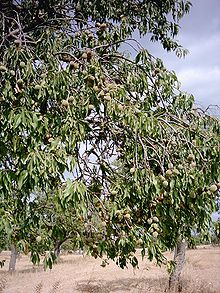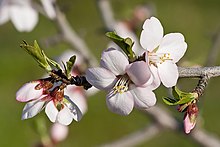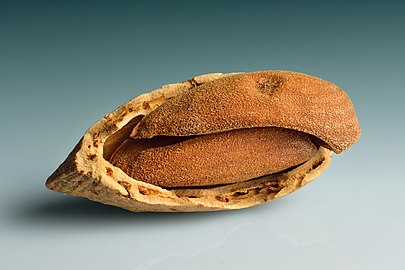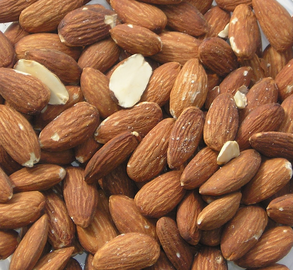
A | B | C | D | E | F | G | H | CH | I | J | K | L | M | N | O | P | Q | R | S | T | U | V | W | X | Y | Z | 0 | 1 | 2 | 3 | 4 | 5 | 6 | 7 | 8 | 9
| Almond | |
|---|---|

| |
| 1897 illustration[1] | |

| |
| Almond tree with ripening nuts. | |
| Scientific classification | |
| Kingdom: | Plantae |
| Clade: | Tracheophytes |
| Clade: | Angiosperms |
| Clade: | Eudicots |
| Clade: | Rosids |
| Order: | Rosales |
| Family: | Rosaceae |
| Genus: | Prunus |
| Subgenus: | Prunus subg. Amygdalus |
| Species: | P. amygdalus
|
| Binomial name | |
| Prunus amygdalus Batsch, 1801
| |
| Synonyms[2][3] | |
|
Replaced syn.
Homotypic
Heterotypic
| |
The almond (Prunus amygdalus, syn. Prunus dulcis) is a species of tree from the genus Prunus cultivated worldwide for its seed, a culinary nut.[4] Along with the peach, it is classified in the subgenus Amygdalus, distinguished from the other subgenera by corrugations on the shell (endocarp) surrounding the seed.[5]
The fruit of the almond is a drupe, consisting of an outer hull and a hard shell with the seed, which is not a true nut.[4] Shelling almonds refers to removing the shell to reveal the seed. Almonds are sold shelled or unshelled. Blanched almonds are shelled almonds that have been treated with hot water to soften the seedcoat, which is then removed to reveal the white embryo. Once almonds are cleaned and processed, they can be stored over time. Almonds are used in many cuisines, often featuring prominently in desserts, such as marzipan.[4]
The almond tree prospers in a moderate Mediterranean climate with cool winter weather.[4] Native to Iran and surrounding countries,[6] including the Levant, today it is rarely found wild in its original setting.[7] Almonds were one of the earliest domesticated fruit trees, due to the ability to produce quality offspring entirely from seed, without using suckers and cuttings. Evidence of domesticated almonds in the Early Bronze Age has been found in the archeological sites of the Middle East, and subsequently across the Mediterranean region and similar arid climates with cool winters.
California produces about 80% of the world's almond supply.[4] Due to high acreage and water demand for almond cultivation, and need for pesticides, California almond production may be unsustainable, especially during the persistent drought and heat from climate change in the 21st century.[8] Droughts in California have caused some producers to leave the industry, leading to lower supply and increased prices.[8]
Description
The almond is a deciduous tree growing to 3–4.5 metres (10–15 feet) in height,[4][9] with a trunk of up to 30 centimetres (12 inches) in diameter. The young twigs are green at first, becoming purplish where exposed to sunlight, then gray in their second year. The leaves are 8–13 cm (3–5 in) long,[10] with a serrated margin and a 2.5 cm (1 in) petiole.
The fragrant flowers are white to pale pink, 3–5 cm (1–2 in) diameter with five petals, produced singly or in pairs and appearing before the leaves in early spring.[4][11][12] Almond trees thrive in Mediterranean climates with warm, dry summers and mild, wet winters.[4] The optimal temperature for their growth is between 15 and 30 °C (59 and 86 °F) and the tree buds have a chilling requirement of 200 to 700 hours below 7.2 °C (45.0 °F) to break dormancy.[13]
Almonds begin bearing an economic crop in the third year after planting. Trees reach full bearing five to six years after planting. The fruit matures in the autumn, 7–8 months after flowering.[12][14]
The almond fruit is 3.5–6 cm (1+3⁄8–2+3⁄8 in) long. It is not a nut but a drupe. The outer covering, consisting of an outer exocarp, or skin, and mesocarp, or flesh, fleshy in other members of Prunus such as the plum and cherry, is instead a thick, leathery, gray-green coat (with a downy exterior), called the hull. Inside the hull is a woody endocarp which forms a reticulated, hard shell (like the outside of a peach pit) called the pyrena. Inside the shell is the edible seed, commonly called a nut.[4] Generally, one seed is present, but occasionally two occur. After the fruit matures, the hull splits and separates from the shell, and an abscission layer forms between the stem and the fruit so that the fruit can fall from the tree.[15] During harvest, mechanized tree shakers are used to expedite fruits falling to the ground for collection.[4]
-
Almond blossoms
-
Young almond fruit
-
Green almonds
-
Mature almond nut
-
Almond shell
-
A rare double-seeded shell
-
Harvested almonds
-
Blanched almonds
Taxonomy
Sweet and bitter almonds


The seeds of Prunus dulcis var. dulcis are predominantly sweet[16][17] but some individual trees produce seeds that are somewhat more bitter.[4] The genetic basis for bitterness involves a single gene, the bitter flavor furthermore being recessive,[18][19] both aspects making this trait easier to domesticate. The fruits from Prunus dulcis var. amara are always bitter, as are the kernels from other species of genus Prunus, such as apricot, peach and cherry (although to a lesser extent).

The bitter almond is slightly broader and shorter than the sweet almond and contains about 50% of the fixed oil that occurs in sweet almonds. It also contains the enzyme emulsin which, in the presence of water, acts on the two soluble glucosides amygdalin and prunasin[21] yielding glucose, cyanide and the essential oil of bitter almonds, which is nearly pure benzaldehyde, the chemical causing the bitter flavor. Bitter almonds may yield 4–9 milligrams of hydrogen cyanide per almond[22] and contain 42 times higher amounts of cyanide than the trace levels found in sweet almonds.[23] The origin of cyanide content in bitter almonds is via the enzymatic hydrolysis of amygdalin.[23] P450 monooxygenases are involved in the amygdalin biosynthetic pathway. A point mutation in a bHLH transcription factor prevents transcription of the two cytochrome P450 genes, resulting in the sweet kernel trait.[24]
Etymology
The word almond is a loanword from Old French almande or alemande,[25] descended from Late Latin amandula, amindula, modified from Classical Latin amygdala, which is in turn borrowed from Ancient Greek amygdálē (ἀμυγδάλη)[25][26] (cf. amygdala, an almond-shaped portion of the brain).[27] Late Old English had amygdales 'almonds'.[26]
The adjective amygdaloid (literally 'like an almond, almond-like') is used to describe objects which are roughly almond-shaped, particularly a shape which is part way between a triangle and an ellipse. For example, the amygdala of the brain uses a direct borrowing of the Greek term amygdalē.[28]
Distribution and habitat
Almond is native to Iran and its surrounding regions,[6] including the Levant area.[7] It was spread by humans in ancient times along the shores of the Mediterranean into northern Africa and southern Europe, and more recently transported to other parts of the world, notably California, United States.[29] The wild form of domesticated almond grows in parts of the Levant.[30]
Selection of the sweet type from the many bitter types in the wild marked the beginning of almond domestication. It is unclear as to which wild ancestor of the almond created the domesticated species. The species Prunus fenzliana may be the most likely wild ancestor of the almond, in part because it is native to Armenia and western Azerbaijan, where it was apparently domesticated.[7] Wild almond species were grown by early farmers, "at first unintentionally in the garbage heaps, and later intentionally in their orchards".[31]
Cultivation



Almonds were one of the earliest domesticated fruit trees, due to "the ability of the grower to raise attractive almonds from seed.[7] Thus, in spite of the fact that this plant does not lend itself to propagation from suckers or from cuttings, it could have been domesticated even before the introduction of grafting".[30] Domesticated almonds appear in the Early Bronze Age (3000–2000 BC), such as the archaeological sites of Numeira (Jordan),[7] or possibly earlier. Another well-known archaeological example of the almond is the fruit found in Tutankhamun's tomb in Egypt (c. 1325 BC), probably imported from the Levant.[30] An article on almond tree cultivation in Spain is brought down in Ibn al-'Awwam's 12th-century agricultural work, Book on Agriculture.[33]
Of the European countries that the Royal Botanic Garden Edinburgh reported as cultivating almonds, Germany[34] is the northernmost, though the domesticated form can be found as far north as Iceland.[35]
Varieties
Almond trees are small to medium sized but commercial cultivars can be grafted onto a different root-stock to produce smaller trees. Varieties include:
- Nonpareil – originates in the 1800s. A large tree that produces large, smooth, thin-shelled almonds with 60–65% edible kernel per nut. Requires pollination from other almond varieties for good nut production.[36]
- Tuono – originates in Italy. Has thicker, hairier shells with only 32% of edible kernel per nut. The thicker shell gives some protection from pests such as the navel orangeworm. Does not require pollination by other almond varieties.[36]
- Mariana – used as a rootstock to result in smaller trees
Breeding
Breeding programmes have found the high shell-seal trait.[37]
Pollination
The most widely planted varieties of almond are self-incompatible; hence these trees require pollen from a tree with different genetic characters to produce seeds. Almond orchards therefore must grow mixtures of almond varieties. In addition, the pollen is transferred from flower to flower by insects; therefore commercial growers must ensure there are enough insects to perform this task.[38] The large scale of almond production in the U.S. creates a significant problem of providing enough pollinating insects. Additional pollinating insects are therefore brought to the trees. The pollination of California's almonds is the largest annual managed pollination event in the world, with over 1 million hives (nearly half of all beehives in the US) being brought to the almond orchards each February.[4][39]
Much of the supply of bees is managed by pollination brokers, who contract with migratory beekeepers from at least 49 states for the event. This business was heavily affected by colony collapse disorder at the turn of the 21st century, causing a nationwide shortage of honey bees and increasing the price of insect pollination. To partially protect almond growers from these costs, researchers at the Agricultural Research Service, part of the United States Department of Agriculture (USDA), developed self-pollinating almond trees that combine this character with quality characters such as a flavor and yield.[36] Self-pollinating almond varieties exist, but they lack some commercial characters. However, through natural hybridisation between different almond varieties, a new variety that was self-pollinating with a high yield of commercial quality nuts was produced.
Diseases
Almond trees can be attacked by an array of damaging microbes, fungal pathogens, plant viruses, and bacteria.[40]
Pests
Pavement ants (Tetramorium caespitum), southern fire ants (Solenopsis xyloni), and thief ants (Solenopsis molesta) are seed predators.[40] Bryobia rubrioculus mites are most known for their damage to this crop.[41]
Sustainability
Almond production in California is concentrated mainly in the Central Valley,[42] where the mild climate, rich soil, abundant sunshine and water supply make for ideal growing conditions. Due to the persistent droughts in California in the early 21st century, it became more difficult to raise almonds in a sustainable manner.[43][39] The issue is complex because of the high amount of water needed to produce almonds: a single almond requires roughly 1.1 US gallons (0.92 imperial gallons; 4.2 litres) of water to grow properly.[42][43][44] Regulations related to water supplies are changing so some growers have destroyed their current almond orchards to replace with either younger trees or a different crop such as pistachio that needs less water.[45]

Sustainability strategies implemented by the Almond Board of California and almond farmers include:[39][46][47]
- tree and soil health, and other farming practices
- minimizing dust production during the harvest
- bee health
- irrigation guidelines for farmers
- food safety
- use of waste biomass as coproducts with a goal to achieve zero waste
- use of solar energy during processing
- job development
- support of scientific research to investigate potential health benefits of consuming almonds
- international education about sustainability practices
Production
| Country | Tonnes |
|---|---|
| 1,858,010 | |
| 360,328 | |
| 245,990 | |
| 190,000 | |
| 175,763 | |
World |
3,630,427 |
| Source: FAOSTAT of the United Nations[48] | |
In 2022, world production of almonds was 3.6 million tonnes, led by the United States (table). Secondary producers were Australia and Spain.
United States
In the United States, production is concentrated in California where 1,000,000 acres (400,000 ha) and six different almond varieties were under cultivation in 2017, with a yield of 2.25 billion pounds (1.02 billion kilograms) of shelled almonds.[49] California production is marked by a period of intense pollination during late winter by rented commercial bees transported by truck across the U.S. to almond groves, requiring more than half of the total U.S. commercial honeybee population.[50] The value of total U.S. exports of shelled almonds in 2016 was $3.2 billion.[51]
All commercially grown almonds sold as food in the U.S. are sweet cultivars. The U.S. Food and Drug Administration reported in 2010 that some fractions of imported sweet almonds were contaminated with bitter almonds, which contain cyanide.[52]
Australia
Australia is the largest almond production region in the Southern Hemisphere. Most of the almond orchards are located along the Murray River corridor in New South Wales, Victoria, and South Australia.[53][54]
Spain
Spain has diverse commercial cultivars of almonds grown in Catalonia, Valencia, Murcia, Andalusia, and Aragón regions, and the Balearic Islands.[55] Production in 2016 declined 2% nationally compared to 2015 production data.[55]
The 'Marcona' almond cultivar is recognizably different from other almonds and is marketed by name.[56] The kernel is short, round, relatively sweet, and delicate in texture. Its origin is unknown and has been grown in Spain for a long time; the tree is very productive, and the shell of the nut is hard.[56]
Toxicity
Bitter almonds contain 42 times higher amounts of cyanide than the trace levels found in sweet almonds.[23] Extract of bitter almond was once used medicinally but even in small doses, effects are severe or lethal, especially in children; the cyanide must be removed before consumption.[23] The acute oral lethal dose of cyanide for adult humans is reported to be 0.5–3.5 mg/kg (0.2–1.6 mg/lb) of body weight (approximately 50 bitter almonds), so that for children consuming 5–10 bitter almonds may be fatal.[23] Symptoms of eating such almonds include vertigo and other typical cyanide poisoning effects.[52]
Almonds may cause allergy or intolerance. Cross-reactivity is common with peach allergens (lipid transfer proteins) and tree nut allergens. Symptoms range from local signs and symptoms (e.g., oral allergy syndrome, contact urticaria) to systemic signs and symptoms including anaphylaxis (e.g., urticaria, angioedema, gastrointestinal and respiratory symptoms).[57]
Almonds are susceptible to aflatoxin-producing molds.[58] Aflatoxins are potent carcinogenic chemicals produced by molds such as Aspergillus flavus and Aspergillus parasiticus.[59] The mold contamination may occur from soil, previously infested almonds, and almond pests such as navel-orange worm. High levels of mold growth typically appear as gray to black filament-like growth. It is unsafe to eat mold-infected tree nuts.
Some countries have strict limits on allowable levels of aflatoxin contamination of almonds and require adequate testing before the nuts can be marketed to their citizens. The European Union, for example, introduced a requirement since 2007 that all almond shipments to the EU be tested for aflatoxin. If aflatoxin does not meet the strict safety regulations, the entire consignment may be reprocessed to eliminate the aflatoxin or it must be destroyed.[60][61]
Breeding programs have found the high shell-seal trait.[37] High shell-seal provides resistance against these Aspergillus species and so against the development of their toxins.[37]
Mandatory pasteurization in California
After tracing cases of salmonellosis to almonds, the USDA approved a proposal by the Almond Board of California to pasteurize almonds sold to the public. After publishing the rule in March 2007, the almond pasteurization program became mandatory for California companies effective 1 September 2007.[62] Raw, untreated California almonds have not been available in the U.S. since then.
California almonds labeled "raw" must be steam-pasteurized or chemically treated with propylene oxide (PPO). This does not apply to imported almonds[63] or almonds sold from the grower directly to the consumer in small quantities.[64] The treatment also is not required for raw almonds sold for export outside of North America.
The Almond Board of California states: "PPO residue dissipates after treatment". The U.S. Environmental Protection Agency has reported: "Propylene oxide has been detected in fumigated food products; consumption of contaminated food is another possible route of exposure". PPO is classified as Group 2B ("possibly carcinogenic to humans").[65]
The USDA-approved marketing order was challenged in court by organic farmers organized by the Cornucopia Institute, a Wisconsin-based farm policy research group which filed a lawsuit in September 2008. According to the institute, this almond marketing order has imposed significant financial burdens on small-scale and organic growers and damaged domestic almond markets. A federal judge dismissed the lawsuit in early 2009 on procedural grounds. In August 2010, a federal appeals court ruled that the farmers have a right to appeal the USDA regulation. In March 2013, the court vacated the suit on the basis that the objections should have been raised in 2007 when the regulation was first proposed.[66]
Uses
Nutrition
 | |
| Nutritional value per 100 g (3.5 oz) | |
|---|---|
| Energy | 2,423 kJ (579 kcal) |
21.6 g | |
| Starch | 0.7 g |
| Sugars | 4.4 g 0.00 g |
| Dietary fiber | 12.5 g |
49.9 g | |
| Saturated | 3.8 g |
| Monounsaturated | 31.6 g |
| Polyunsaturated | 12.3 g |
21.2 g | |
| Tryptophan | 0.214 g |
| Threonine | 0.598 g |
| Isoleucine | 0.702 g |
| Leucine | 1.488 g |
| Lysine | 0.580 g |
| Methionine | 0.151 g |
| Cystine | 0.189 g |
| Phenylalanine | 1.120 g |
| Tyrosine | 0.452 g |
| Valine | 0.817 g |
| Arginine | 2.446 g |
| Histidine | 0.557 g |
| Alanine | 1.027 g |
| Aspartic acid | 2.911 g |
| Glutamic acid | 6.810 g |
| Glycine | 1.469 g |
| Proline | 1.032 g |
| Serine | 0.948 g |
| Vitamins | Quantity %DV† |
| Vitamin A equiv. | 0% 1 μg1 μg |
| Vitamin A | 1 IU |
| Thiamine (B1) | 18% 0.211 mg |
| Riboflavin (B2) | 78% 1.014 mg |
| Niacin (B3) | 21% 3.385 mg |
| Pantothenic acid (B5) | 9% 0.469 mg |
| Vitamin B6 | 8% 0.143 mg |
| Folate (B9) | 13% 50 μg |
| Choline | 9% 52.1 mg |
| Vitamin C | 0% 0 mg |
| Vitamin D | 0% 0 μg |
| Vitamin E | 171% 25.6 mg |
| Vitamin K | 0% 0.0 μg |
| Minerals | Quantity %DV† |
| Calcium | 20% 264 mg |
| Copper | 110% 0.99 mg |
| Iron | 21% 3.72 mg |
| Magnesium | 64% 268 mg |
| Manganese | 99% 2.285 mg |
| Phosphorus | 39% 484 mg |
| Potassium | 24% 705 mg |
| Selenium | 5% 2.5 μg |
| Sodium | 0% 1 mg |
| Zinc | 28% 3.08 mg |
| Other constituents | Quantity |
| Water | 4.4 g |
| †Percentages estimated using US recommendations for adults,[67] except for potassium, which is estimated based on expert recommendation from the National Academies.[68] | |

Almonds are 4% water, 22% carbohydrates, 21% protein, and 50% fat. In a 100-gram (3+1⁄2-ounce) reference amount, almonds supply 2,420 kilojoules (579 kilocalories) of food energy. The almond is a nutritionally dense food, providing a rich source (20% or more of the Daily Value, DV) of the B vitamins riboflavin and niacin, vitamin E, and the essential minerals calcium, copper, iron, magnesium, manganese, phosphorus, and zinc. Almonds are a moderate source (10–19% DV) of the B vitamins thiamine, vitamin B6, and folate, choline, and the essential mineral potassium. They also contain substantial dietary fiber, the monounsaturated fat, oleic acid, and the polyunsaturated fat, linoleic acid. Typical of nuts and seeds, almonds are a source of phytosterols such as beta-sitosterol, stigmasterol, campesterol, sitostanol, and campestanol.[69]
Health
Almonds are included as a good source of protein among recommended healthy foods by the U.S. Department of Agriculture (USDA).[70] A 2016 review of clinical research indicated that regular consumption of almonds may reduce the risk of heart disease by lowering blood levels of LDL cholesterol.[71][72]
Culinary
While the almond is often eaten on its own, raw or toasted, it is also a component of various dishes. Almonds are available in many forms, such as whole, slivered, and ground into flour. Almond pieces around 2–3 millimetres (1⁄16–1⁄8 in) in size, called "nibs", are used for special purposes such as decoration.[73]
Almonds are a common addition to breakfast muesli or oatmeal.
-
Almond cream cake covered in slivered almonds
-
Colomba di Pasqua, traditional Italian Easter bread
- Zdroj:https://en.wikipedia.org?pojem=Almond_oil
Text je dostupný za podmienok Creative Commons Attribution/Share-Alike License 3.0 Unported; prípadne za ďalších podmienok. Podrobnejšie informácie nájdete na stránke Podmienky použitia.
Antropológia
Aplikované vedy
Bibliometria
Dejiny vedy
Encyklopédie
Filozofia vedy
Forenzné vedy
Humanitné vedy
Knižničná veda
Kryogenika
Kryptológia
Kulturológia
Literárna veda
Medzidisciplinárne oblasti
Metódy kvantitatívnej analýzy
Metavedy
Metodika
Text je dostupný za podmienok Creative
Commons Attribution/Share-Alike License 3.0 Unported; prípadne za ďalších
podmienok.
Podrobnejšie informácie nájdete na stránke Podmienky
použitia.
www.astronomia.sk | www.biologia.sk | www.botanika.sk | www.dejiny.sk | www.economy.sk | www.elektrotechnika.sk | www.estetika.sk | www.farmakologia.sk | www.filozofia.sk | Fyzika | www.futurologia.sk | www.genetika.sk | www.chemia.sk | www.lingvistika.sk | www.politologia.sk | www.psychologia.sk | www.sexuologia.sk | www.sociologia.sk | www.veda.sk I www.zoologia.sk











